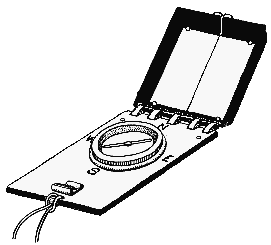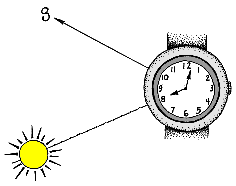If you do become lost, stay where you are. Build a fire and carefully assess the situation. Do not use precious energy by wandering aimlessly.
During the winter months use game trails which will help you avoid walking in the deep snow. Frozen streams and rivers are also easy to follow but watch for weak ice.
MEASURING DISTANCE
When measuring distance the most effective method is the tally and pace system:
1 pace = 75 cm (29.25 in)
1 double pace = 150 cm or 1.5 m (58.5 in)
66 double paces = 99 m (107.9 yards) = 1 tally (tie a knot in a string for each tally)
10 tallies = 1000 m or 1 km (0.62 mi)
FINDING DIRECTION
 Using a Compass
Using a Compass
(Note: When using a compass in coastal British Columbia, it will read 22 degrees east of true north. More time must be allowed to read a bearing during the winter months as it takes longer for the needle to finish swinging.)
A magnetic-Sylva type compass is a lost hiker's best friend. First, decide which direction you want to follow then aim over the centre of your compass to the bearing you want to follow and find a landmark on this sighting. After arriving at this landmark repeat the process. Using this pattern you will follow a relatively straight line.
 Using the Stars
Using the Stars
For those unfortunate enough to not have a compass, using the pole star for direction will suffice. Simply located the pole star and you will be facing north. To find this star use the Big Dipper constellation. The pole star will be located off of the top of the "dipper", on the opposite side of the handle.
 Using the Sun
Using the Sun
You may also use your watch and the sun to determine direction. Point the hour hand directly at the sun and then bisect the angle between the hour hand and twelve o'clock. This imaginary line will run north/south.
METHODS OF NAVIGATION
There are three common methods of navigation:
1. Map reading is a common method used, particularly in developed areas. Maps and aerial photos may be used when landmarks are clear.
2. Using a compass in conjunction with maps and aerial photos is wise in areas without good landmarks.
3. Navigation by dead reckoning is common in areas where landmarks are non-existent or inadequate. This method combines plotting and recording of a series of courses, measured by distance and direction from a starting point.
* It is important to stay alert and observe all unusual landmarks.
Difficulties in navigation may occur for several reasons. Some of these include
WHEN YOU'RE LOST IN THE WOODS
The most important thing to remember if you find yourself in this situation is not to panic. First, treat any injuries within your party. Next, establish that your basic needs are met. These include heat, shelter, water and food. Then consult your map and compass and try to recognize or remember landmarks you may have passed.
To determine how many hours of daylight are left, face the sun and extend your arm towards it. Bend your wrist inwards and place your fingers just below the sun. Disregarding your thumb, count how many fingers separate the sun from the horizon. Each finger will represent fifteen minutes.
If it is nearing dark, build a shelter and fire that is on high ground and out of the wind. Have a snack and a hot drink and get some rest. Don't waste precious energy by trying to find your way in the dark.
During daylight hours it is important to find a way to signal to others. A fire is best. Be sure to find a means with which to carry water. If you must move be sure to leave markers that searchers can follow.
SIGNALS
A fire is the safest method to use when signaling for help. The smoke is easily spotted during the day and the flames by night. Three signal fires laid 30 m (98 feet) apart and lit when a aircraft passes is a good way to indicate your distress. The Morse Code emergency signal is S...O...S... and may be sent with a flashlight and consists of three dots followed by three dashes followed by three dots. The dashes should be twice as long as the dots. Messages or signal letters may be drawn in the snow. A signal mirror is also a very effective method used. Flash the mirror along the horizon regardless of whether a plane is in view.
Before venturing into the wilderness check weather forecasts and hazards.
http://www.bcadventure.com/adventure/wilderness/survival/travel.htm
No comments:
Post a Comment